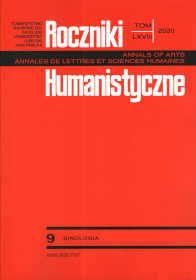„Elegia o rzece” (Heshang) – spór o symbole, interpretację przeszłości i wizję przyszłości Chin
“River Elegy” (Heshang): An Argument about Symbols, Interpretation of China’s Past and a Vision of Its Future
Author(s): Lidia KasarełłoSubject(s): Anthropology, Social Sciences, Culture and social structure
Published by: Towarzystwo Naukowe KUL & Katolicki Uniwersytet Lubelski Jana Pawła II
Keywords: TV miniseries Heshang (河殇, “River Elegy”); Chinese cultural debates; Chinese cultural nationalism; Great China; tradition; modernity; westernization
Summary/Abstract: Heshang (河殇, “River Elegy”), a TV miniseries (1989) directed by Xia Jun and produced due to the inspiration from various circles participating in the cultural debates (wenhua re 文化热) of the 1980s, is one of the most important cultural texts belonging to identity discourse which deals with the issue of the controversy between Chinese and Western civilisation. During two periods of China’s opening up to the world, which contextualised the phenomenon of contemporary cultural nationalism (Zhongguo wenhua minzuzhuyi 中国文化民族主义), an important scientific and social debate on the choice of paths for China’s development took place. Both in the 1920s and 1980s, this dispute concerned an assessment of the past and the fundamental dichotomy between tradition and modernity. The “River Elegy”, which synthesised, in a way, the discussion of the Chinese intellectual elites on this subject, is divided into six episodes: “In Search of a Dream” (Xunmeng 寻梦), “Destiny” (Mingyun 命运), “A Glimmering Light” (Lingguang 灵光), “A New Epoch” (Xinjiyuan 新纪元), “Sorrows and Crises” (Youhuan 忧患) and “Azure” (Weilanse 蔚蓝色). In the multi-level narrative built around the main story, documentary materials, interviews, discussions and numerous quotations, Chinese cultural emblems (e.g. the dragon) and expressive metaphors serve as the guiding thread intertwining the whole message: Old China can only rejuvenate its culture via modernisation and Westernisation. Its emotional reception is reinforced by the introduction of a model that polarises the colour and cardinal symbols of China. The two poles include the Yellow River, which epitomises the backward civilisation of feudal China, and the blue ocean, representing the modern, industrial West, and the Great Wall, as well as the Silk Road—symbols of isolation and openness. An analysis of Heshang shows that the original goal of strengthening the reformer camp was not achieved. The broadcasting of the series ended with a fierce political campaign, while the filmmakers themselves, instead of declaring their approval for the Enlightenment project, revealed their attachment to the idea of a Great China.
Journal: Roczniki Humanistyczne
- Issue Year: 68/2020
- Issue No: 9
- Page Range: 119-138
- Page Count: 20
- Language: Polish

